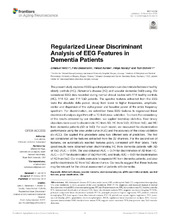| dc.contributor.author | Neto, Emanuel | |
| dc.contributor.author | Biessmann, Felix | |
| dc.contributor.author | Aurlien, Harald | |
| dc.contributor.author | Nordby, Helge | |
| dc.contributor.author | Eichele, Tom | |
| dc.date.accessioned | 2017-08-04T11:42:59Z | |
| dc.date.available | 2017-08-04T11:42:59Z | |
| dc.date.issued | 2016-11-30 | |
| dc.Published | Neto E, Biessmann, Aurlien H, Nordby H, Eichele T. Regularized linear discriminant analysis of EEG features in dementia patients. Frontiers in Aging Neuroscience. 2016;8:273 | eng |
| dc.identifier.issn | 1663-4365 | |
| dc.identifier.uri | https://hdl.handle.net/1956/16216 | |
| dc.description.abstract | The present study explores if EEG spectral parameters can discriminate between healthy elderly controls (HC), Alzheimer’s disease (AD) and vascular dementia (VaD) using. We considered EEG data recorded during normal clinical routine with 114 healthy controls (HC), 114 AD, and 114 VaD patients. The spectral features extracted from the EEG were the absolute delta power, decay from lower to higher frequencies, amplitude, center and dispersion of the alpha power and baseline power of the entire frequency spectrum. For discrimination, we submitted these EEG features to regularized linear discriminant analysis algorithm with a 10-fold cross-validation. To check the consistency of the results obtained by our classifiers, we applied bootstrap statistics. Four binary classifiers were used to discriminate HC from AD, HC from VaD, AD from VaD, and HC from dementia patients (AD or VaD). For each model, we measured the discrimination performance using the area under curve (AUC) and the accuracy of the cross-validation (cv-ACC). We applied this procedure using two different sets of predictors. The first set considered all the features extracted from the 22 channels. For the second set of features, we automatically rejected features poorly correlated with their labels. Fairly good results were obtained when discriminating HC from dementia patients with AD or VaD (AUC = 0.84). We also obtained AUC = 0.74 for discrimination of AD from HC, AUC = 0.77 for discrimination of VaD from HC, and finally AUC = 0.61 for discrimination of AD from VaD. Our models were able to separate HC from dementia patients, and also and to discriminate AD from VaD above chance. Our results suggest that these features may be relevant for the clinical assessment of patients with dementia. | en_US |
| dc.language.iso | eng | eng |
| dc.publisher | Frontiers | eng |
| dc.rights | Attribution CC BY | eng |
| dc.rights.uri | http://creativecommons.org/licenses/by/4.0 | eng |
| dc.subject | Alzheimer’s disease | eng |
| dc.subject | vascular dementia | eng |
| dc.subject | electroencephalogram | eng |
| dc.subject | qEEG | eng |
| dc.subject | quantitative analysis | eng |
| dc.subject | spectral features | eng |
| dc.subject | group classification | eng |
| dc.subject | LDA | eng |
| dc.title | Regularized linear discriminant analysis of EEG features in dementia patients | eng |
| dc.type | Peer reviewed | |
| dc.type | Journal article | |
| dc.date.updated | 2017-05-10T08:02:13Z | |
| dc.description.version | publishedVersion | |
| dc.rights.holder | Copyright 2016 The Author(s) | eng |
| dc.identifier.doi | https://doi.org/10.3389/fnagi.2016.00273 | |
| dc.identifier.cristin | 1446960 | |
| dc.source.journal | Frontiers in Aging Neuroscience | |

